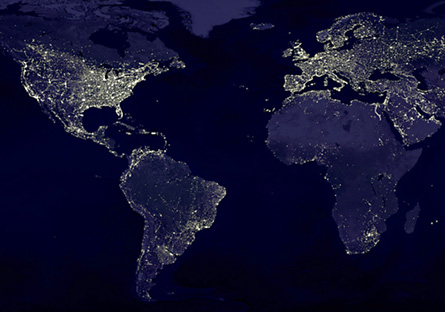Darkness, melatonin may stall breast and prostate cancers
New studies suggest people need to respect the body’s desire for nighttime darkness
To stay healthy, the body needs its zzz’s. But independent of slumber, human health also appears to require plenty of darkness — especially at night. Or so suggests a pair of new cancer studies.

One found that among postmenopausal women, the lower the overnight production of melatonin — a brain hormone secreted at night, especially during darkness — the higher the incidence of breast cancer. The second study correlated elevated prostate cancer incidence around the world with places that have the brightest signatures of light in satellite imagery.
Trends seen in both studies bolster animal data indicating that natural nighttime peaks in blood concentrations of melatonin, which tend to occur during sleep, depress the growth of the hormonally sensitive cancers.
Light will depress the body’s natural secretion of that hormone, whether someone is awake or asleep.
In 2001, Eva S. Schernhammer of Brigham and Women’s Hospital in Boston and her colleagues found an elevated risk of breast cancer among women who worked night shifts. The data, gleaned from participants in the long-running Nurses’ Health Study, fit with the idea that the light encountered while working nocturnal hours would have suppressed the women’s melatonin production.
Melatonin data were not available for these nurses, however. So to test a melatonin link to cancer, more than 18,500 of the participating nurses were asked to collect their early morning urine on one occasion between 2000 and 2002 for a follow-up analysis.
Between then and 2006, 357 of the women who were not night-shift workers went on to develop breast cancer. Schernhammer and Susan E. Hankinson of the Harvard School of Public Health in Boston then correlated melatonin concentrations in the urine from these women with the hormone’s overnight excretion by 533 nurses in the study who had remained cancer-free yet matched most of the characteristics of the first group, such as age and history of factors that could affect melatonin or cancer risk — including smoking or drinking.
In the January Cancer Epidemiology, Biomarkers & Prevention, Schernhammer and Hankinson now report finding a drop in cancer risk as nighttime melatonin values rose. Compared to women at the lowest values, those in the highest showed a roughly two-thirds lower risk of developing breast cancer. Concludes Schernhammer, “We showed the natural variation in nighttime melatonin production predicts breast-cancer risk.”
“This is an important confirmatory study” linking melatonin and breast cancer, says David E. Blask of the Tulane University School of Medicine in New Orleans. “Such epidemiological studies are associative; they can’t really determine causation,” he notes. But the more such data accumulate, “the stronger the case you can make — especially when you put it together with what we know from experimental studies about melatonin, light at night and breast cancer.”
His own studies showed that when scientists injected blood from women with normally high nighttime melatonin concentrations into human breast tumors implanted into rats, the growth of those tumors was suppressed. In contrast, blood from women who had been exposed to light at night — knocking down their melatonin concentrations — fueled the cancers’ growth.
Recently, his team has been conducting similar work on rats implanted with human prostate cancers. Blood from animals exposed to light at night fueled the tumor growth while blood rich in melatonin “dramatically decreased the tumor cells’ proliferative activity,” Blask reports. “We were able to block this effect,” he adds, with a drug that blocks the ability of melatonin to dock with its hormone receptor on cells. “So we know that the mechanism works through the melatonin receptor.”
Now an ecologic study finds implied support for a melatonin effect on prostate cancer in men. Three Israeli scientists teamed up with Richard Stevens, of the University of Connecticut Health Center in Farmington, who originated the 1987 hypothesis linking melatonin suppression with cancer. The team analyzed U.S. nighttime global satellite imagery for 164 nations and correlated light emissions in each country — or in subregions of large countries — with incidence data for the three leading male cancers: prostate, lung and colon.
“We found a significant positive association between population exposure to light at night and incidence rates of prostate cancer, but no such association with lung cancer or colon cancer,” the team reports in the January Chronobiology International. Areas with the highest amounts of light at night had a prostate cancer rate more than double that in regions with the lowest average nighttime lighting.
“We predicted — and the data now say — that prostate cancer is quite strongly related to light at night,” Stevens says. He concludes that people must learn to respect their bodies’ need for darkness. That’s why he now advocates that people reduce in-home illumination after sundown as much as safety allows, especially in later hours.
Indeed, “With normal [indoor] room lighting at night, melatonin is suppressed in everybody,” says Steven W. Lockley of Harvard Medical School in Boston. Onset of the hormone’s secretion can be pushed about an hour-and-a-half later than would occur in the absence of light, he adds.
Turn the lights off and melatonin secretion rates will return to normal, he says. But health implications of a chronic, nightly shortfall of melatonin due to spending evenings in well lit rooms remain unknown, he observes, so it’s probably best to err on the side of keeping nighttime lighting dim.







